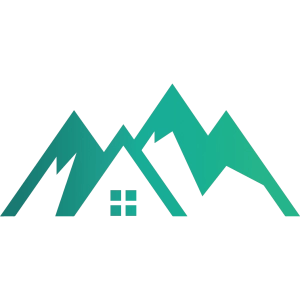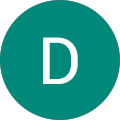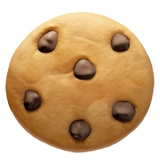Slovenia is a top hiking destination with trails everywhere around its mountain ranges. Even though the country is small, its landscape is so diverse, and the natural beauties so many that it’s easy not to see enough. That’s why hiking from one hut to another is the best way to see as much of its picturesque mountain scenery as possible while waking up every day in a new environment. Its alpine ranges are covered very well by the 163 huts managed by the Alpine Association of Slovenia.
To make the planning of your hut-to-hut tour in Slovenia easier, we have prepared this guide that touches on the most important things for you to consider.
Best time of year to hike in Slovenia
Most huts are open from June to September. Before June, there’s usually still a lot of snow in the mountains. In October, a few of them stay open if there’s no early snow, but most of them finally close in November, when winter comes.
The most beautiful time to go is in early summer since the nature surrounding you is all green and blooming. There are also fewer people in June, and the day is long. The more you are closing in on the high season in August, the more people there are, temperatures are higher and the weather becomes more unstable.
That’s why September is much better in these last two aspects since the temperatures are perfect, the weather stable and the huts less crowded than in August. Still, the new downsides are very cold mornings and shorter days.
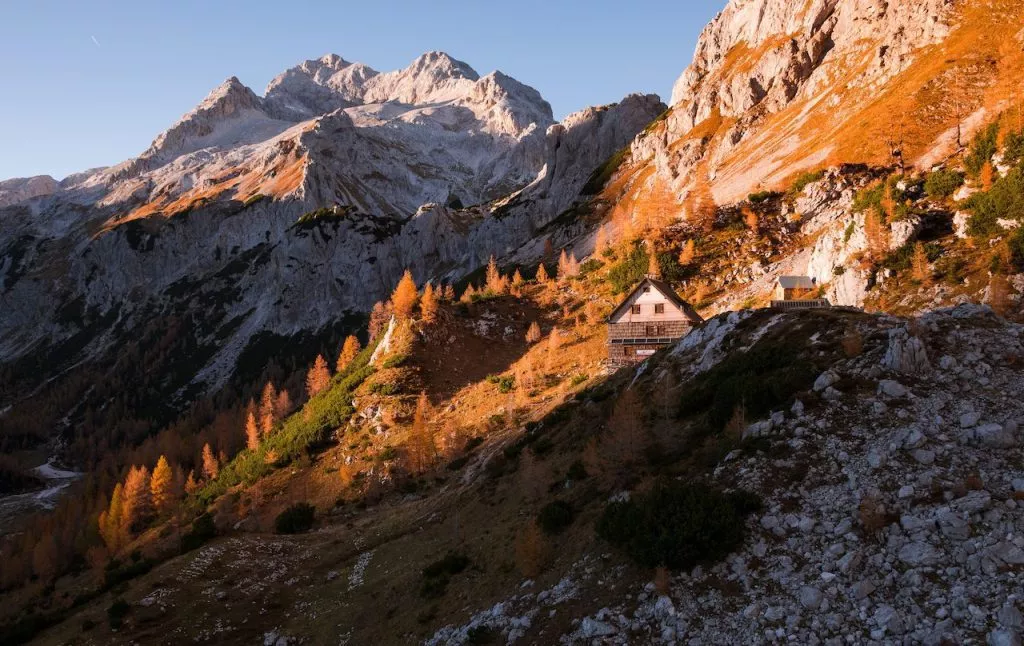
Daily weather
The main thing you have to consider about the weather in the summer is the heat and the afternoon storms. That’s why it’s best to start your hikes early in the morning to avoid these two things. A good rule of thumb is to start descending before noon when the temperature is the highest, and clouds begin gathering around the peaks.
Of course, that is not true for every day of summer, so it’s good to always check the daily weather forecast before planning your hike. Even though the temperatures can get very high during the day, they can sometimes be around zero in the morning. Additionally, when clouds block the sun and the wind starts blowing, the temperatures that were too high a minute ago turn into too cold in a second.
On a more positive note, there are also days without any storms, which are the best for hiking and are more prevalent the closer to autumn you get. The most important thing to remember is – check the local weather forecast, specialized for the mountains. Those forecasts are only reliable a few days ahead – you can check the weather forecast for the next three days in Slovenian Alps here.

About the huts
There are a lot of huts in the Slovenian mountains, which have many commonalities between them. These are some things to keep in mind:
- What comfort to expect: As the huts are often secluded and “away from civilization”, the general comfort is basic, but they are clean and cosy and have everything you need for a comfortable overnight stay.
- Sleeping accommodation: Most huts have both dormitories and separate rooms, with the latter usually booked first. If you want to sleep in a private room, it’s better to book your accommodation early. The beds are generally comfortable, while the huts also provide you with blankets, bedding and pillows, but you can also bring your own liner for extra hygiene. Sometimes a liner is requisite, and if you don’t have your own you have to buy a disposable one.
- Water and showering facilities: Lower-altitude lodges usually have their own drinking water source, while most high-altitude ones do not. They get their water supply by helicopter deliveries. Most still collect rainwater for toilets, while showers are a luxury only possible in low-altitude huts.
- Food and Drinks: Huts offer authentic traditional homemade dishes like stews, sausages, goulash etc. Breakfast is usually eggs or different kinds of spreads with bread, so taking the half-board package is worth it. Regarding drinks, you can buy bottled water for around 4,5 € per 1,5 litres. They also serve beer, wine and some home-brewed schnapps. For a quick boost of energy, they also offer snacks like chocolate bars.
- Mountain hut etiquette: Visitors must behave in a manner that doesn’t disturb others, which means there are quiet hours from 10 PM until 5 AM. That’s why those who wake up earlier should do so as quietly as possible. Smoking inside the huts is also not allowed, and everyone must take their own trash back down to the valley.
Huts in the Slovenian mountains are quite popular, which means they are often quite crowded. To find a good place to sleep, it’s best to book them early.
To get a sense of what the huts are like, check out the list of our favourite mountain lodges.
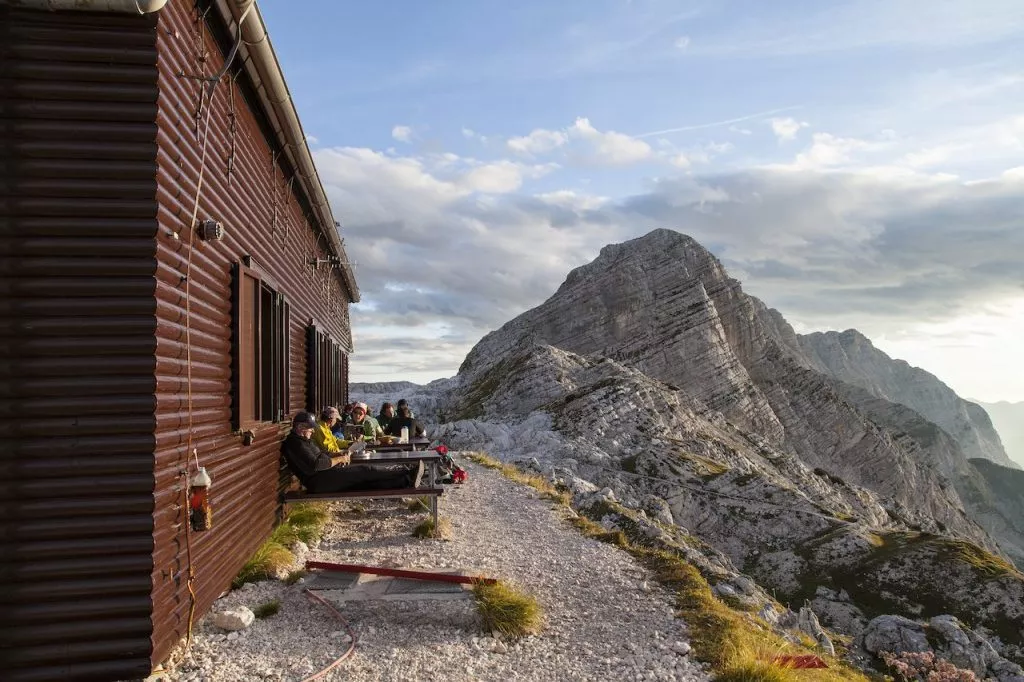
What to take on a hut-to-hut tour?
Try to pack light and only take what is necessary. It is always good to plan according to the route, the weather and other specific conditions, which means it’s best to consult with a guide before doing so.
Clothing:
- Comfortable sports clothes
- Sports shoes with good grip
- Insulation jacket
- Extra layers
- Rain jacket
- Headwear
- Gloves
- Spare socks, underwear and shirts
Even though it is summer and the weather is warm, it’s good to take enough extra layers, so you don’t get cold when the temperatures suddenly drop. We also recommend having a good softshell jacket for wind protection, and a rain jacket when the forecast is sketchy.
The most important item you’ll have with you are your shoes. They need to be comfortable and previously worn, as that will lessen your chances of getting blisters substantially. Never go on a multi-day tour with new shoes! Low-cut hiking shoes or trail running shoes are good enough for any summer tour in Slovenia when the weather is dry. But the shoes must be sturdy enough to protect your feet from the rocks and have a grippy outsole that prevents slippage. Do not go on a hike in regular sports sneakers! In early summer (for crossing the snow left) or rainy days, it’s better to wear high-cut waterproof shoes or even boots.
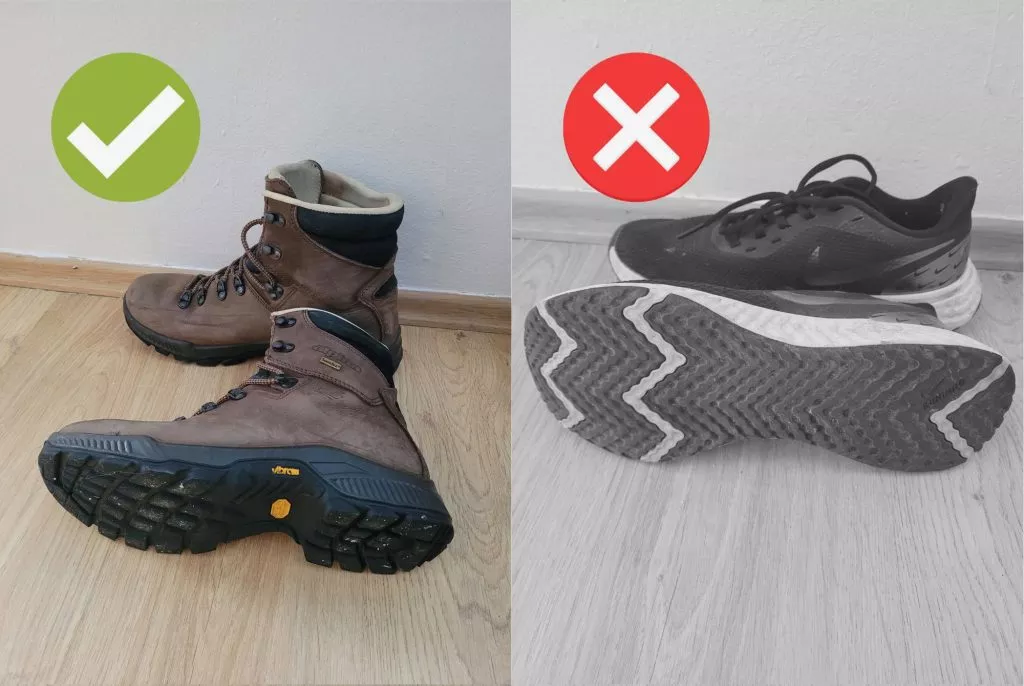
For overnight stays in huts:
- Sleeping liner (disposable can be bought in the hut)
- Some cash for food and accommodation
- UIAA membership card for accommodation discount
- Toothbrush
- Earplugs
- ID card
- Powerbank (power sockets are often taken)
Credit cards are usually accepted in huts, but because they depend on the unreliable internet signal, it’s best to also take enough cash. An ID card is necessary for the hut check-in, where you can also present your UIAA membership card to get a discount. A sleeping bag is not needed, as the hut provides all the blankets, bedding and pillows.
Other equipment:
- Hiking backpack 25-30 l
- Trekking poles (if you are used to them)
- Snacks (for the time between huts)
- Water bottle with enough water and a sports drink with electrolytes
- Sunscreen
- Toilet paper
- Headlamp
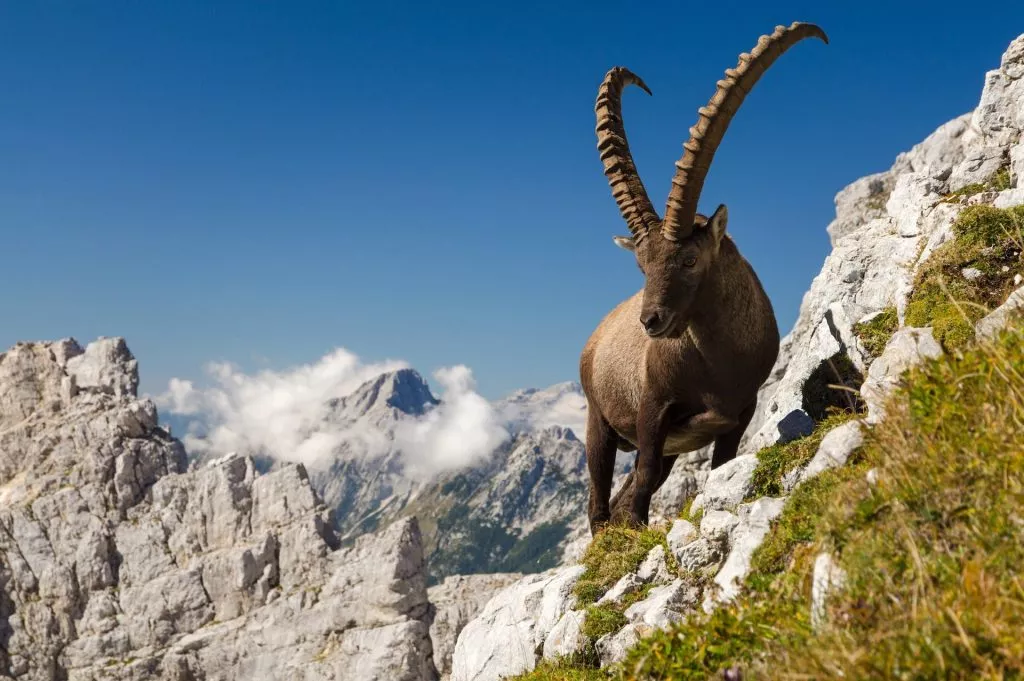
Hiking routes in Slovenia
Slovenia has more than 10,000 kilometres of marked hiking trails, ranging from easy walks to difficult climbs. We also have some long-distance trails, and except for the Slovenian Mountain Trail and the Via Alpina, most of them run through valleys (Juliana Trail, Alpe-Adria Trail etc.).
Planning a tour in the high mountains requires more knowledge. It’s not easy to get information about the time needed to hike from hut to hut since routes are mostly marked and timed from an access point in the valley to the final destination. The times needed are approximate and sometimes not uniform, so your hiking time can vary, depending on how used you are to a type of terrain.
The more popular routes are marked well, but some of the less known ones are not, so it can even look like there is no path there. The crossroad signs also list many different destination names, which can be confusing if you aren’t familiar with them.
The difficulty scale of Slovenian hiking trails consists of:
- Easy trails: Walking without the use of hands.
- Difficult trails: Occasional use of hands. Steel cables and other equipment to increase safety.
- Very difficult trails: Use of hands is mandatory with steel cables, iron pegs and other equipment on the route to ease your way up and increase safety.
While you don’t need much hiking experience on easy trails, you shouldn’t underestimate them. The difficulty scale only describes how technical the terrain is, but says nothing about the length and steepness of the trail or the ease of orientation. The difficult trails often have steel cables and other equipment to increase safety, but their condition varies. It’s best to research each route separately, before setting off on a hike.

How to best plan your hut-to-hut tour in Slovenia?
There are a lot of different aspects one has to consider when planning a hut-to-hut tour in Slovenia – booking the huts, local weather, knowing the terrain, the timetables. That’s why it’s best to have someone experienced in your group who can help you with all of that.
Of course, a local friend as a guide is one option, but that can sometimes give you false confidence. The fact that someone is from Slovenia doesn’t automatically mean he is an experienced hiker.
If you want to have a safe and enjoyable experience hut-to-hut hiking in Slovenia, our team of professional hiking enthusiasts is here to help you. We are that reliable local friend, but with a lot more knowledge and experience, so we can take care of the planning of the tour down to the details. That way your main task is to enjoy the scenery and the adventure the Slovenian mountains have to offer.
Check out the Slovenia hut to hut hikes we offer, or contact us with your wishes, so we can plan your amazing custom hut to hut tour together.
